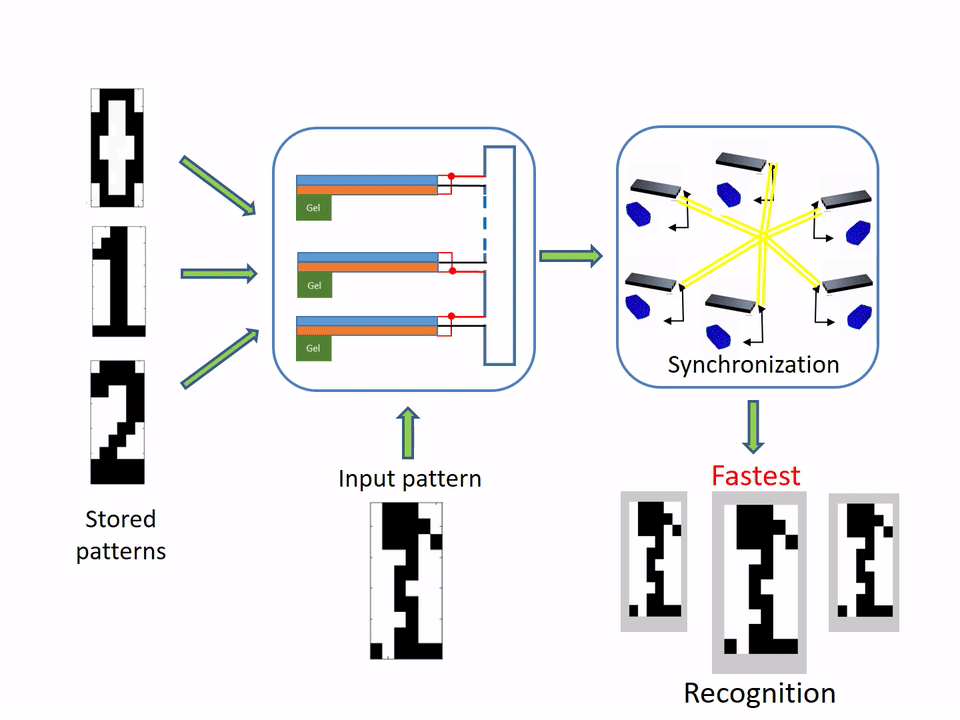Sep 6 2016
 Conceptual illustration of pattern recognition process performed by hybrid gel oscillator system (Credit: Yan Fang)
Conceptual illustration of pattern recognition process performed by hybrid gel oscillator system (Credit: Yan Fang)
Researchers at The University of Pittsburgh's Swanson School of Engineering have demonstrated for the first time that the concept of “materials that compute” can possibly be developed to detect simple patterns. This latest breakthrough brings us one step closer towards such hybrid materials.
Driven by its own chemical reactions, the responsive and hybrid material could potentially be incorporated into clothing to track the human body, or could even be developed as a skin for “squishy” robots.
The study titled “Pattern recognition for materials that compute,” has been reported in the AAAS journal, Science Advances. It continues the study of Steven P. Levitan, the John A. Jurenko Professor of Electrical and Computer Engineering, and Anna C. Balazs, Distinguished Professor of Chemical and Petroleum Engineering.
Co-investigators of the study include Victor V. Yashin, Research Assistant Professor of Chemical and Petroleum Engineering; and Yan Fang, lead author and graduate student researcher in the Department of Electrical and Computer Engineering
Belousov-Zhabotinsky (BZ) gels with an overlaying piezoelectric (PZ) cantilever were used for computational modeling. BZ gel is a substance that moves back and forth without any external stimuli.
The BZ-PZ units integrate Dr. Levitan’s know-how in oscillator-based computing systems and computational modeling, and Dr. Balazs’ research in BZ gels.
BZ-PZ computations are not digital, like most people are familiar with, and so to recognize something like a blurred pattern within an image requires nonconventional computing. For the first time, we have been able to show how these materials would perform the computations for pattern recognition.
Dr. Anna C. Balazs, University of Pittsburgh
Mr. Fang and Dr. Levitan initially stored a numerical pattern as a series of polarities in the BZ-PZ units, and coded the input patterns via the first phase of the oscillations forced on these units. The computational modeling showed that the input pattern that nearest to the stored pattern was the most effective at detecting patterns and displayed the quickest convergence time to the steady synchronization behavior.
In this analysis, the materials were programmed so that they could detect the black-and-white pixels in the shape of numbers, which had been distorted.
These computations are slow and take a long time compared to a standard computer. Nevertheless, Dr. Yashin observed that the results obtained are comparable to nature, which shifts at a “snail’s pace.”
Individual events are slow because the period of the BZ oscillations is slow, however, there are some tasks that need a longer analysis, and are more natural in function. That’s why this type of system is perfect to monitor environments like the human body.
Dr. Victor V. Yashin, University of Pittsburgh
According to Dr. Yashin, this type of device could help patients who are recuperating from a hand injury. These individuals can wear a glove that not only tracks their movements, but also informs physicians if the patients have improved mobility or if the hand is healing properly.
Another potential application of the device would be to track patients at risk for early onset Alzheimer’s disease. Individuals could wear footwear that would examine gait and compare the results obtained against normal movements. People at risk of a stroke or heart disease could wear a garment that tracks their cardiovascular activity.
As the devices are able to change chemical reactions into electrical energy, external electrical power would not be required. This would be suitable for other devices, including robots, that could use the material as a sensory skin.
“Our next goal is to expand from analyzing black-and-white pixels to grayscale and more complicated images and shapes, as well as to enhance the devices storage capability,” Mr. Fang said. “This was an exciting step for us and reveals that the concept of “materials that compute” is viable.”
The study is supported by a five-year National Science Foundation Integrated NSF Support Promoting Interdisciplinary Research and Education (INSPIRE) grant, which focuses on pressing and complex scientific issues underlying at the junction of conventional disciplines.
As computing performance technology is approaching the end of Moore’s law growth, the demands and nature of computing are themselves evolving. This work at the University of Pittsburgh, supported by the NSF, is an example of this groundbreaking shift away from traditional silicon CMOS-based digital computing to a non-von Neumann machine in a polymer substrate, with remarkable low power consumption. The project is a rare example of much needed interdisciplinary collaboration between material scientists and computer architects.
Sankar Basu, NSF Program Director